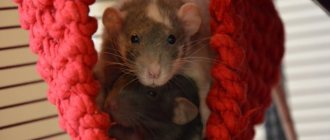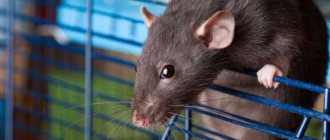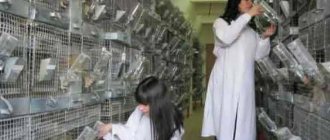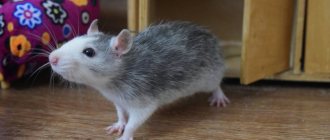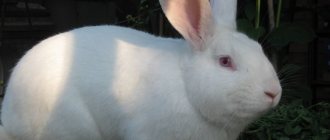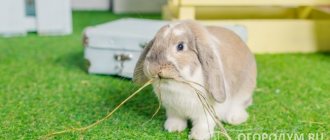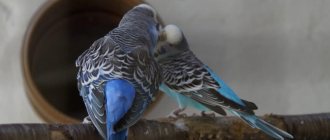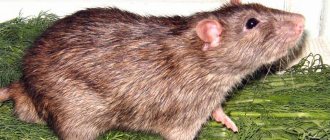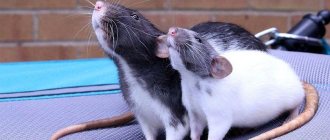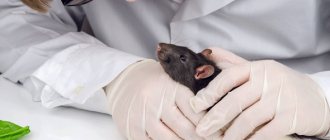Determining whether a female is pregnant can be challenging, especially if potential breeding has not been planned. This can be a very worrying time as a rat owner.
Pregnancy is a normal part of the life cycle. For the most part, the female's pregnancy proceeds smoothly, as nature intended. Sometimes this is not the case. This article will cover questions regarding normal aspects of pregnancy, problems that may arise during pregnancy, and factors that may affect pregnancy.
Pregnancy detection
To detect pregnancy in a female, it is not recommended to palpate the rat’s belly. Often the babies are too small to be felt in the womb, and even the gentlest manipulation can damage them. Palpation is safer after fetuses reach 14 days of age, but should still be done with extreme caution.
Traditional signs of pregnancy include:
- Termination of the estrus cycle.
- Copulation plug after mating.
- Changes in behavior.
- Weight gain.
- Hair loss around the nipples.
- Construction of a nest.
- Enlarged lower abdomen.
Let's look at each of the symptoms in more detail.
Preparation for crossing
For healthy offspring, it is necessary to select a healthy pair of males and females with the necessary breeding characteristics.
Female
In this case, the age of the female, especially the primiparous one, is quite important. Individuals older than five but younger than ten months are suitable for reproduction. Females can become pregnant as early as 5-6 weeks. But it is not recommended to mate earlier than four months of age. If an individual bears offspring during this period, then crossing can be continued for up to a year.
Male
Diet and age affect the sexual activity of males. The appropriate age to start mating is six months. You can continue to mate a male until the end of his life. If a male has not mated at a young age, then his activity may decrease significantly.
Changes in behavior
Pregnancy changes the hormonal balance in female rats, which can sometimes cause changes in behavior. Your once docile rat may become more aggressive and territorial towards both people and other rats. An eccentric or aggressive female may become calmer.
Once pregnant, the female rat also shows no interest in males. A pregnant female will not react in any way to the smell of a male. A fertilized rat may also be more interested in food and steal from other females, and may be more protective of its food and hide it.
Weight gain tracking
Weighing your female rat before mating can give you a good basis for determining weight gain during pregnancy. It is also the most reliable method of determining and monitoring pregnancy from the very beginning.
- Scales
The best options for this are a small digital kitchen model with a flat surface or removable bowl large enough to accommodate an adult rat. Use a scale that will weigh in grams as accurately as possible.
- Signs of weight gain
The female may begin to gain weight within 24 hours of mating. In fact, there may be very few days during the entire pregnancy when a rat does not gain weight.
Daily weight gain ensures that babies are growing throughout pregnancy. The amount of weight a female will gain will depend on her early pregnancy weight, her diet, and the number of children she is carrying.
Once you start weighing your pregnant females, you can see a very clear picture of immediate, significant weight gain. This indicator is important to monitor during the period of slow steady gain with very significant weight gain in the last few days.
A typical full-term fetus averages 5-6 grams. A large litter can mean a lot of extra weight for your female. Healthy females with a decent litter can gain up to 90 grams. Sometimes a rat carries such a small litter that it makes it virtually impossible for the owner to determine pregnancy before giving birth.
- Weight fluctuations during pregnancy
Although weight gain is used to monitor a healthy pregnancy, it can also be used as a tool to help identify problems. Weight may vary during pregnancy. You may experience slight weight loss, a few days without weight gain, or sudden weight gain. These abnormalities are not necessarily abnormal or indicative of a problem.
Time passed without weight gain or continued weight loss usually indicates problems.
Persistent weight loss is usually a sign of reabsorption. Often weight loss is 12 grams per day or more. For the most part, fruits are reabsorbed without problems.
Sometimes incomplete reabsorption can lead to uterine infection. After losing a litter, monitor your female for any signs of infection or illness, such as abnormal vaginal discharge, high (or low) temperature, lethargy, persistent or obvious bleeding, loss of appetite, etc. A sick female should be seen immediately examined by your veterinarian.
Nutrition
Breeding rats presupposes a proper diet for rodents. After selecting individuals, it is necessary to adjust their diet in order to remove excess weight and make them more active.
To increase the endurance of a pregnant female, it is necessary to include wheat germ, eggs, fish and poultry in her diet. In this case, you need to exclude strawberries, vegetable oils, bell peppers and boiled liver from your diet.
Clean and fresh water in the drinking bowl is a vital element in the diet of ornamental rats, especially during the mating period. In addition, it is recommended to place the animals in a separate spacious cage for free movement.
Nesting
As pregnancy nears the end, certain hormones that increase maternal behavior in rats increase as well as decrease. When these changes occur, the female begins to build a nest. You can be sure that the babies will arrive within a few days. Some females build very simple nests, while others build complex ones that completely conceal the young.
In late pregnancy, it is a good idea to provide the female with nesting material. Try to avoid fabrics with holes or ties, as these can suffocate or injure your baby. You may also consider removing the hammocks or moving the female to a single-level cage to avoid injuring the babies who might fall. (Occasionally, females will build nests and give birth on ledges, in hammocks, or in hanging pipes.)
Birth of the brood
Throughout the entire period of childbirth, the female should be in silence, darkness and peace. Otherwise, labor may be disrupted. If the pregnancy proceeded normally, the individual is healthy, then an uncomplicated birth lasts for an hour to an hour and a half. There can be from eight to fifteen rat pups in a litter.
After giving birth, you should not disturb the nursing individual, at least until the tenth day, when the young will leave the nest on their own.
It is worth avoiding cases when there are two females with cubs in a cage. They can be aggressive to the point of eating the brood of another individual.
After giving birth, the female must have a varied diet and water. Often, lack of water can cause a mother to eat her litter. After 5 weeks, the cubs must be separated from their mother to prevent the mother from fertilizing her sons. 6 weeks after birth, you need to separate yourself and the males in the litter separately.
Stages of pregnancy
Once a female rat is fertilized, her entire system begins to change as her body prepares for the growth and development of her offspring. At 21-24 days after conception, 3 stages of pregnancy are distinguished. Let's look at the obvious changes you'll see in a rat at different stages.
- First stage of pregnancy
Appearance of a rat.
There are no immediate visual changes after conception. The fetuses are too undeveloped to cause any noticeable weight gain in the mother (although if you weigh the female, you will see the weight gain).
Appetite.
You may begin to notice a slightly increased appetite as her body requires more nutrition and energy to send to her children.
Behavior.
Most females do not show noticeable changes in behavior early in pregnancy. However, in others you may notice detachment or lack of energy.
The female will no longer go into estrus after fertilization. She will not be interested in the smell of a male rat.
- Second stage of pregnancy
Appearance.
In the second week of pregnancy, the female will begin to gain weight. She will look like a well-fed rat. Her hips may begin to widen a little. Towards the end of the second week, you may feel a slight swelling in your abdomen, although pressing on this area is not recommended as it may harm the fetus.
Appetite.
Appetite will increase and it is important to give your mother rat healthy treats as well as staple foods such as kibble.
Behavior.
No heats and no interest in the scent of male rats. May sleep more, may bite sometimes.
- Third stage of pregnancy
Appearance.
In the last week of pregnancy, the rat will change dramatically in appearance. Her weight will increase by leaps and bounds. And her belly will become pronounced and rounded. Some breeders describe a prenatal rat as if it had "swallowed a tennis ball" or "swallowed an orange." The hips will noticeably expand. If a rat is carrying a large litter, the skin may stretch to the point that the fur on its back appears thinner. This is most often seen in Rex rats.
Babies can now be felt by gently touching the belly, although it may hurt them if you press too hard. At the end of pregnancy, you may see movement in the abdomen as the baby reaches full term.
The nipples will become more pronounced and the hair around them will become thinner, making them easier for newborns to access.
Appetite.
Females with large litters may experience a sharp increase in appetite as their bodies require more food to feed their babies. Healthy treats and free feedings with healthy staples are encouraged throughout pregnancy.
Behavior.
As your rat approaches birth, he may show signs of aggression. This will depend on each rat. Some females never show aggression during pregnancy. Others will bite and want to be left alone.
The female may sleep more in the last week of pregnancy. She also usually builds a nest in anticipation of the upcoming birth.
Pairing
It is necessary to replant the male during the period of estrus. It occurs in females in the interval from four to ten days and lasts up to one day. During this period, the behavior of the individual changes. False matings can be observed when other females try to mount a female in heat. In such a female, the appearance of the vaginal opening changes - it acquires a purple tint, becomes open and wet. If you touch such an individual from above, it begins to arch its back and vibrate its ears.
Typically, rats need one male and one female to breed. But there are cases when mating occurs only when two or three females move in with the male. After birth, it is necessary to remove the male from the cage to avoid re-fertilization, because estrus is restored 36 hours after the birth of the brood.
Pregnancy can be tracked by the absence of estrus after a certain period of time. The abdomen enlarges after two to three weeks.
Vitamins and minerals during pregnancy
Deficiencies of vital nutrients can affect fertility and the health of offspring. It is important to provide your breeding and nursing rats with a well-balanced diet that meets their nutritional needs.
Vitamin A.
It has been proven that a lack of vitamin A throughout a rat's pregnancy leads to changes in the placenta and, as a result, to embryonic defects in addition to infertility.
Vitamin A is also critical during embryological growth, when cells multiply, and can lead to defects in the hindbrain, heart and skeleton. Deficiency later in life in rats can lead to abnormalities in the eyes, kidneys, heart, lungs and genitourinary system.
Severe deficiency of this vitamin can cause fetal death, which occurs when maternal tissue reserves are so depleted that they are markedly diminished in the ocular system, one of the last areas to lose its supply. Vitamin A is also needed during breastfeeding to replenish breast milk.
Vitamin B
Vitamin B deficiency two weeks before mating reduces female fertility by up to 80%. Vitamin B and folic acid are beneficial for neural tube development and help compensate for some birth defects such as anencephaly.
Copper.
A lack of copper during pregnancy reduces copper levels in the brain and impedes the development of the nervous system. Poor coordination associated with motor function may be a sign of copper deficiency.
Environmental factors during pregnancy
Environmental factors that can have a negative impact on pregnancy include stress, lighting and temperature, cigarette smoke, medications, pesticides and solvents.
Stress.
The response of rats to stress is regulated by hormones. Severe stress can cause abnormal physiological changes such as glandular dysfunction, decreased ovulation and implantation, insufficient lactation, susceptibility to disease and increased infant mortality and even spontaneous abortion. In extreme cases, females have been known to devour their young when stressed.
Excessive handling and noise can cause stress. Rats' keen hearing makes them sensitive to high-pitched sounds. Many research centers have modified alarm systems to avoid disturbing mothers with newborns.
Light.
Light and dark cycles are also important when breeding rats and they need to be provided with 12 hours of light and 12 hours of darkness. Deviation from this cycle can affect the reproductive process. Duration and type of lighting may also influence behavior during estrus. Rats exposed to noise and flashing lights during pregnancy had increased absorption rates and fetal weight variability.
Minor fluctuations in temperature and humidity have been shown to cause decreased reproductive performance. Proper ventilation can have an impact by reducing the spread of disease. This also ensures a stable temperature and reduces the likelihood of drafts.
Smoke.
Exposure to second-hand smoke in rats in utero leads to increased sensitivity of the aortic rings, which causes impairment of vascular smooth muscle function. Cyanide in tobacco smoke can also cause decreased levels of vitamins B12 and C.
Newborn rats whose mothers were exposed to smoke during pregnancy exhibit decreased bone formation. Histological changes were observed in the lungs, liver, kidneys, stomach and intestines of young rats, including bronchial muscle hyperplasia, which is a precancerous stage.
Medicines.
Medicines that can affect impotence in male rats include diazepam, chlorpromazine, and estrogens. Tetracycline given to pregnant women can interfere with the development of fetal bones and teeth. Aspirin causes birth defects in rats.
Toxic substances.
Chemical plasticides, pesticide surfactants, and PCBs are associated with reproductive tract malformations and infertility in male animals.
Features of breeding decorative rats
When getting a female, you need to know that a decorative rat at home is ready to breed throughout the year. Therefore, it is important to know how to care for a pregnant rat, how to help during childbirth if difficulties arise, and what to do with the offspring.
If you decide to breed rats on a professional level, you need to select only healthy rats for a pair; before mating, you need to pay attention to the diet of the future parents.
By approaching this issue with all seriousness and responsibility, you will get healthy offspring.
Types of breeding
In order for the offspring to be born viable and beautiful, experienced breeders recommend breeding only one type of rat. This kind of breeding is called pure breeding; the advantages of this type are the preservation of the basic qualities of the species and their improvement. Pure breeding is divided into linear and family.
Linear type - for reproduction they take rodents that have common parents, the successor of the family is a male, the female is selected according to external characteristics.
Family species - both females and males from common parents, which are selected according to certain parameters, can be used for reproduction.
In order to breed a new species of decorative rat, not only linear individuals are crossed, but even from different species.
In addition to these species, inbreeding is distinguished - mating of closely related individuals other than mother and son. This method allows you to draw not only a clean line, but also to emphasize the best qualities of a certain type. But such offspring can have various mutations, viability decreases and such a genus simply degenerates.
According to the observations of experienced breeders, in order to get the best results when breeding decorative rats, you need to take two females and one male. To breed Dumbo rats, they take representatives of the same genus, at least 6 months old.
Factors affecting reproduction
The most basic factor that has a significant impact on reproduction is health. A genetic factor or an unfavorable environmental situation can provoke the development of various ailments in subsequent generations. The table contains a detailed list of possible unfavorable factors and the consequences they cause:
| Heredity | Ecology/Environment |
| Minor Recessions | Mutations |
| Sudden mutations | Severe diseases of various organs |
| Genetic incompatibility | Weak immunity |
Besides health, an important factor is the rat's temperament. Experienced breeders recommend paying attention to their character: rats that show aggression are not recommended as a breeding pair.
